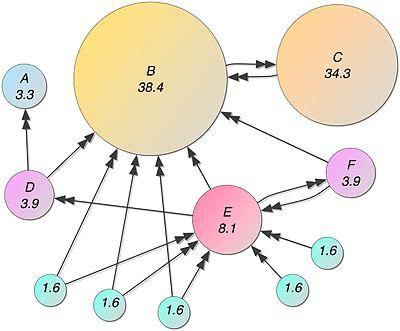Website Links for SEO
Conveniently located to serve the areas of Undefined
SEO-savvy content links are a crucial part of your site’s ranking success. Although they are not the end-all-be-all to SEO strategy, content links continue to be an important source of information in determining the best methods to achieve a strong search rank.
Employing a strong content link strategy requires the full attention of an experienced professional. A successful linking strategy is a challenge for even the most capable SEO pro, and naturally an even more daunting task for a busy medical practitioner and their practice staff.
Below, we’ll walk you through the many of the fundamentals of Google’s linking machinery and shed some light on the art of building quality content links.
Contents
PageRank Algorithm
Links or URLs are at the heart of the Google algorithm.
In January 1996, Larry Page and Sergey Brin, the founders of Google, had begun collaboration on a search engine called BackRub (later renamed Google), named for its unique ability to analyze the “back links” pointing to a given website. The founders had their “AHA!” moment when they realized that if they utilized links as votes for websites (PageRank algorithm), their search engine would provide superior results over all the other major search engines at that time, including Yahoo!, Lycos, Infoseek, AltaVista, and Ask Jeeves. The number of links paired with the anchor text (text describing what the link is for) indicated the preferred result for given keywords based on searchers’ votes.
PageRank (PR) is an algorithm used by Google to rank websites by their search engine results. PageRank was named after Google co-founder, Larry Page. PageRank measures the importance of website pages.
PageRank uses its vast link structure, reflecting the uniquely democratic nature of the web, as an indicator of an individual page’s value. In essence, Google interprets a link from page A to page B as a vote, by page A for page B. But Google looks at considerably more than the sheer volume of votes or links a page receives; it also analyzes the page that casts the vote. Votes cast by pages considered “important” weigh more heavily, making those other pages “important.”

PageRank is not the only algorithm used by Google to order search engine results, but it is the best-known and the first one the company used.
Paid/Unnatural Links
Ever since people understood the role links played in Google rankings, people have tried to manipulate the system with Black Hat tactics, which is very much a cat-and-mouse game. Google tries to block black hat tactics; if they catch you doing them, they penalize the website you are trying to rank. The following is provided by Google to describe what they view as unnatural links:
“Any links intended to manipulate PageRank or a site’s ranking in Google search results may be considered part of a link scheme and a violation of Google’s Webmaster Guidelines. This includes any behavior that manipulates links to your site or outgoing links from your site.”
The following are examples of link schemes which can negatively impact a site’s ranking in search results:
- Buying or selling links that pass PageRank, such as exchanging money for links or posts that contain links; exchanging goods or services for links; or sending someone writing pertinent content containing the link in exchange for a “free” product. Excessive link exchanges (“Link to me and I’ll link to you”) or partner pages created exclusively for cross-linking.
- Large-scale article marketing or guest posting campaigns with keyword-rich anchor text links.
- Using automated programs or services to create links to your site.
Additionally, unnatural links (those not editorially placed or vouched for by the site’s owner on a page) may violate Google’s guidelines. Here are a few common examples:
- Text advertisements that pass PageRank.
- Advertorials or native advertising where payment is received for articles that include links that pass PageRank.
- Links with optimized anchor text in articles or press releases distributed on other sites.
- Low-quality directory or bookmark site links.
- Keyword-rich, hidden, or low-quality links embedded in widgets that are distributed across various sites.
- Widely distributed links in the footers or templates of various sites.
- Forum comments with optimized links in the post or signature.
The best way to get other sites to create high-quality, relevant links to yours is to create unique, relevant content that naturally gains popularity in the Internet community. Creating good content pays off: Links are usually editorial votes given by choice. The more useful content you have, the greater the chances someone else will find that content valuable to their readers and link to it.
Google Penguin Algorithm Update
Google launched the Penguin Update in April 2012 to better catch sites deemed to be spamming its search results by buying links or obtaining them through link networks designed primarily to boost Google rankings.
Google’s war on low-quality content started with the Panda algorithm update, and the Penguin update was an extension and addition to the arsenal for fighting this war. Penguin was Google’s response to the increasing practice of manipulating search results (and rankings) through black hat link building techniques. The algorithm’s objective was to gain greater control over and reduce the effectiveness of a number of black hat spamming techniques.
By better understanding the types of links websites and webmasters were earning, Penguin was a step towards ensuring that natural, authoritative relevant links rewarded the websites they pointed to, while manipulative and spammy links were downgraded.
If your site’s rankings have taken a hit since Google Penguin, you probably need help. If you don’t act quickly, your traffic from Google will continue to diminish and your website may be completely removed from their index and not even show up at all.
To start, you’ll need to identify bad links and either have them removed or “disavow” them. You can disavow links through Google’s disavow tool, which allows you to upload a file with URLs and domains that you have links from, saying: “I don’t want these links to count.”
If search engines place a manual penalty on your website for having an excessive amount of unnatural links, you will need to request websites that linked to you unnaturally to remove those links. Be sure to record those emails. If they do not remove the links, then you need to disavow the links and email Google to explain all of the steps you have taken to correct the problem. After you complete the two-part action of removing the problematic elements and essentially asking Google for forgiveness, they should remove the penalty and re-index your website.
Google can identify unnatural links by seeing an exact phrase that appears in a high number of links, all of which attach to your site at almost the same time. For example, you may have 100 links from usually low-quality websites where the anchor text all says the same thing.
Example of a link where the anchor text says “Breast Augmentation”:
https://growthmed.com/procedures/breast/augmentation
Low Quality Links Are Hurting Your Rankings
The example above shows a link that goes to your breast augmentation page. The anchor text with the keywords that you should receive “votes” for is “Breast Augmentation,” meaning you are trying to rank for the term “Breast Augmentation.” Having an unnatural amount of people from low-quality websites linking to you all at once with the exact same phrase is unnatural on the web. It can potentially work in the short term, but if you are caught, your entire website can be penalized all at once.
Low-quality links are never worth it!




















































